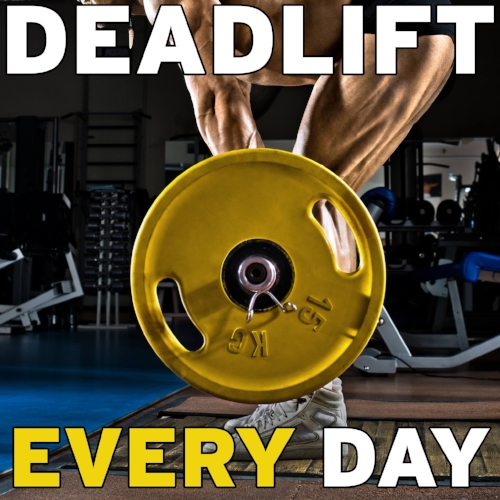How To Use Light Weights To Get Big
It used to be believed that muscular growth could only occur in the presence of sufficiently heavy weights. If you ask your standard gym bro, they’ll probably tell you that you have to use sets for something in the 8-15 rep range, which roughly corresponds with about 65-80% of your single repetition max.
It was believed that anything above this rep range (typically 15+ per set, or anything under about 65%) was simply too light to generate sufficient muscular activation, though it could be useful for developing endurance and developing strength of the tendons and connective tissue.
Likewise, it was believed that lifting with weights above 80% (anything fewer than about 8 reps per set) is great for developing strength and the neural patterns needed for strength, but that this weight was too heavy to generate enough metabolic stress to challenge the muscle, leading to less growth.
Last week, I released my "no load" exercise article, which showed that recent research shows that we can gain muscle without using any weight at all. Clearly, there's something going on.
I remember very well how, when CrossFit came on the scene, bodybuilders scoffed at CrossFitters because they said that “CrossFit kills gains” and that it was impossible that their high rep, high intensity workouts could build any muscle.
Of course, this looks pretty silly when we see how jacked elite CrossFit competitors like Rich Froning, Mathew Fraser, and Jason Khalipa are. Likewise, CrossFit is known for producing numerous women with impressive physiques, including Annie Thorisdottir, Samantha Briggs, Camille Leblanc Bazinet, and more.
I won’t deny the possibility (as always) of the use of chemical assistance to achieve these physiques. At high levels of any sport, the use of performance enhancing drugs is always a possibility.
I’ll also say that from a pure physique perspective, CrossFit may not be the best approach. However, from even a cursory glance it’s clear that CrossFit does not, in fact, kill gains. This seems like initial evidence that in fact, yes, high repetition workouts can build a lot of muscle.
More recently, Brad Schoenfeld ran a meta-analysis and a study on exactly this topic. What the researchers found was that there was no significant difference in muscular growth when using a wide variety of repetition ranges, with the caveat that all sets were taken to failure (you can no longer do any more reps).
Likewise, Greg Nuckols did his own statistical analysis, and found similar results. What he also noted was that there was a slight tendency for there to be less muscle growth at the extremes (near 100% or significantly below 50%).
In Greg’s analysis, he notes that it’s likely that while the traditional hypertrophy range isn’t necessarily significantly better, it’s probably optimal for most people. Sets near 100% intensity are particularly physically and mentally taxing, making it hard to achieve a great deal of training volume. Likewise, sets significantly below the traditional range can still achieve the same level of size, but training to “failure” becomes much more confusing.
When we lift weights, it’s a combo of mechanical tension (can our muscles produce enough force?) and metabolic distress (can we get energy into those muscles quickly enough that they can produce that force again?). When mechanical tension is the limiting factor, it’s pretty clear where our limits are - we simply can’t lift the bar again, and this happens pretty quickly at intensities above 60% or so.
But when sets are significantly below that, it’s primarily metabolic factors in play. This makes it much harder to judge our actual limits.
Say I’m working at a weight I could perform about 30 reps at for a max. The limits are so much fuzzier: could I handle 30 reps? Or maybe 31? Or maybe with an extra breath I could handle 32? It’s just so much more difficult to accurately judge our limits that we can’t be sure if we’re really going to failure. This problem is amplified the lighter the weight gets, where it gets close to "cardio".
There are some other issues. A challenging set of 8 might only take you a few seconds, but a challenging set of 50 might take you a few minutes - and both would theoretically cause the same amount of size growth. That means that over time, it would take a lot longer to get the same effect.
Another important note is that the strength ranges still show themselves to be clearly superior for building strength, and the endurance ranges still show themselves to be clearly superior for building endurance.
So, if you’re training for a particular sport, you need to train using a rep range that’s in line with your goals, even if all rep ranges can still build muscle. For those exercisers specifically looking to build muscle, it’s probably a good idea to train in a variety of ranges so that you develop a well-balanced profile of both strength and endurance, both of which can help you move more weight and build more muscle in the long term.
As a result, it does happen that the traditional growth range seems to be optimal. But, there are alternatives, and those alternatives have important implications for training:
Heavier than optimal: may not generate as much size, but necessary for building strength, particularly for strength athletes, sport athletes, and anyone looking to get stronger. Significant dropoff at the highest intensities, but you shouldn’t be training that intensely that often anyway.
Lighter than optimal: workouts may be longer and it may be harder to accurately judge failure, but great for building endurance, and required for those people training for endurance (such as CrossFit athletes). Also, the lighter overall weight used means that you’re probably less likely to hurt yourself, and it’s more useful for beginners, women, and those with compromised function due to age or injury. The use of “no weight” training, or BFR, may help in conjunction with high rep sets.
There’s a greater range of rep ranges that can cause growth than people expect. Be flexible with your training, and train in a variety of intensities in order to make yourself a well-rounded exerciser or athlete. This has the added benefit of making your training a little less boring, as well! Simple, but effective.
Enjoy this post? Share it on Facebook or Twitter.
Takeaway Points:
It was commonly believed that serious muscle could only be built in the 8-15 rep range.
However, research shows that you can build muscle equally in any rep/intensity range (including no load exercise), so long as sets are taken to near failure. As always, the rules of progression apply.
Training at particularly heavy or light intensities presents other challenges that may make it harder to train to failure, so the traditional 8-15 rep range is still most generally useful.
That being said, it’s a good idea to work in a variety of rep ranges in order to be more well-rounded, and certain rep ranges may be more important for certain exercisers depending on their training goals and individual needs.
Further Reading:
Are you interested in perfecting your deadlift and building legendary strength and muscle? Check out my free ebook, Deadlift Every Day.
Interested in coaching? Inquire here. You can also subscribe to my mailing list, which gets you the free GAINS exercise program for maximizing strength, size, and endurance.


